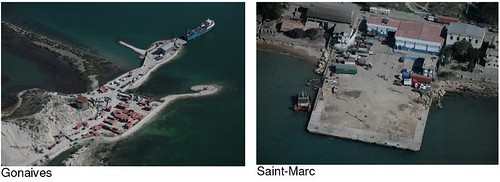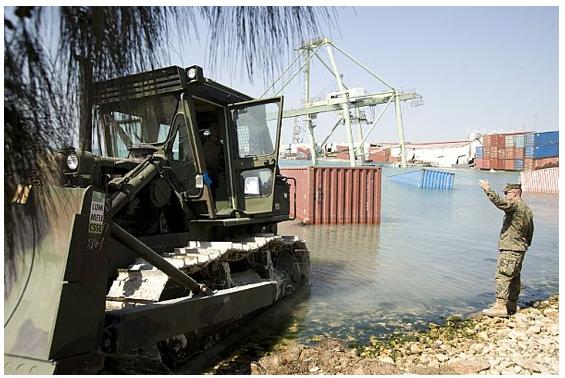JMAC Ports, Cargo and Fuel Facilities Assessment
18 January 2010
Assessment: Port-au-Prince does no longer have the capacity to take in cargo ships as the public port / APN wharf collapsed, although beach off-loading can remain an option. Saint-Marc and Gonaives ports are in good shape and operational and could be used as alternate facilities. The only two points of entry for fuel in the country suffered important damages, in particular the TEVESA / Varreux terminal in Cité Soleil that is currently unusable. Thor terminal in Carrefour, although affected, could reportedly still operate. Although a quick-fix could be possible through temporary hoses in order to supply the country with fuel, JMAC could not receive any information in that sense to date.
JMAC/U2/U7 Observations following recce flight led by Uruguayan aviation on
16/01/2010
Gonaives private port is clear and operational, with lifting capacity and an estimated 7 to 8m depth. Public port remains unsuitable for offloads.Saint-Marc port seems undamaged but has no lifting capacity; with an estimated depth of 5m, it can take in medium-sized ships.

Carrefour / Thor-Le Volant oil terminal
The pier and pipes are damaged at several locations as piling collapsed on several points. As a result, a leak of heavy oil slick (already sunk) stretches over a few square kilometers moving west.
The tanks need an on-foot check but appear to be intact from the air. Warehouses seem in good shape and stable. The power plant is still probably operational. According to DINASA representatives, Thor can still be functioning and the company is awaiting a shipment. However, recce flights showed that both the pier and pipes were damaged and leaking, with a few square kilometers slick of heavy oil moving west. It remains unclear to date if the shipment announced by DINASA would be delivered through the pipes. Tanks appear to be in good condition. They are located at a short distance from the shore –an advantage if temporary hoses are to be installed.

APN / Public port
The new wharf completely disappeared under the water with the two mobile cranes. A third crane that was stored between the two main dock facilities is still standing but probably needs repair. Storage facilities are tilted and unsafe as the whole wharf area sloped to the sea. It was flooded and covered with mud coming out of significant cracks in the ground.
A part (around 100m) of the old pier collapsed after Ford Island. Buildings on Ford Island (customs and port administration) were located suffered severe damages and can no longer be used. Cars and containers in the sea as well as the probably insufficient depth by the shore make it extremely hazardous to try to come alongside what is left of the pier.
Varreux
Crane is jacked off and wharf sustained major cracks. A large portion of the main pier collapsed and is under the water. Pipes appear broken.

That's the "what."
Here is the "so what." The Navy-Marine Corps team has a unique opportunity to look again at what they need to move large amounts of man and material ashore in a semi-permissive environment. Semi-permissive runs the whole gambit from humanitarian assistance, consequence management, all the way to warfighting.
If you think you can do it all with the U/H/C/SH-60 family of rotary wing, LPD-17, MV-22, and LCAC then you are not thinking right.
Lots of good lessons here - if we want to listen to them. Lots of ideas on how to leverage MSC and USNR - if we want to own them.
"What's next?" The QDR. That bolt is already shot - got to spin from here. BTW, if you want to play - tune in to Midrats next Sunday - that is the topic.
Finally, doing what Sailor and Marines are best at - getting the job done. a shot that begs the question; is this in your ROC/POE?

PORT-AU-PRINCE, Haiti (Jan. 25, 2010) Service members working with U.S. Marine Corps 8th Engineer Support Battalion use a bulldozer to remove submerged container boxes. Military engineers are conducting salvage and repair operations in the main seaport in Port-au-Prince, Haiti during Operation Unified Response. (U.S. Navy photo by Mass Communication Specialist 2nd Class Chris Lussier/Released)









14 comments:
Would it be possible to use Saint Marcs for unloading RO-ROs?
ROC and POE ?
Great opportunities abound here... build it like an excercise of war... see what the material resources are and make it happen.
Rewind to 1983. We made it to Grenada... any lessons learned there? or what about Tarawa? or Tinian ? see we do have a history with this sort of thing...
SINK AN OLI RIG as a "MULBERRY" and build a causeway... really how hard is that?
ROC = Required Operational Capability
POE = Projected Operational Environment
Might be possible, but would likely be difficult to get the vehicles off that mole.
MTH. Yes. But I read ROC and PEO initially and thought there had been a change but was not sure. PEO is in the (shudder) Acquisition world.
I don't know the approaches to Saint Marcs' mole, but perhaps the overtaxed SEABEEs or Marine engineers could spare a Cat or two to open a way? Or have bridging equipment and come Cats as the first things off the RO-RO.
I think the points about what is inland? are more critical than getting ships in to port? I have great confidence in the ACBs and combat engineers to clear out the berths and put in some pier structure when their necessary equipment is on hand. The Seabees etc will have much more to contend with extending the road network inland (its just a bigger task) time consuming and the main roads are also for other traffic and pedestrians too.
But to begin with more pontoons and boats and divers and Seabees and combat engineers doing what is probably not in their ROC/POE? And more power to them! Get the aviation centric dreamers to back off. I just heard their are 1800 flights backed up waiting to fly to PaP. How many days will that take and where will all that come off the aircraft go?
This sounds remarkably like a job for the crane ships, SS Cornhuster State and Gopher State were activated last week, not sure when they're do to arrive, may even be on station by now . . . this is precisely what this ships were built for. Not sure of the status on the other four, but if they're not already underway, time to shift colors!
I was thinking the same thing since, as you correctly state, this type of situation is why the Navy developed these ships. Two of them are based in Bremerton, WA, so think it's probably unlikely that they'll be activated.
T-ACS were developed to be an interface between sealift ships and smaller ship and lighters. That was expected to be done at anchor. To that one has to ask: is there a berth with adequate depth alongside? So I see the crane ships out in the harbor.
Most recently the older T-ACS were being moved down to NDRF from RRF
The ACB battalions can set up a roll on roll off discharge platform at sea and unload the ro ro on to navy and army lighterage (INLS OR NL).
The amphib seabees are not as overtaxed as the 1NCD seabees and are standing by to assist.
The answer Joint Logistics Over the Shore (JLOTS). I am still trying to figure out what the powers at be are waiting for?
Post a Comment